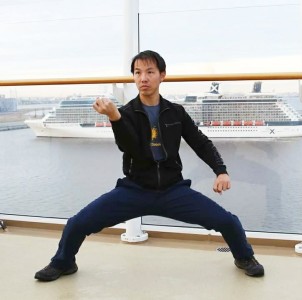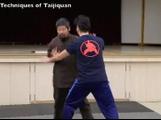 Yi (intent) is not just a thought. In my current understanding, yi describes an ability for your body to do a precise action as you command it to do. In other words, your body listens to your brain. It takes training to get to that state. Master Chen Zhonghua has said before, “the real intent is no intent”. Think about riding a bike as an example. After you have learned how to ride a bike, you don’t think about how to coordinate your hands and feet, how to balance, you only think about where to want to go. You appear to be able to do it with ease. For taijiquan, we need to train long enough to make an action habitual, so that we don’t think about it when we need it, and it just comes out.
Yi (intent) is not just a thought. In my current understanding, yi describes an ability for your body to do a precise action as you command it to do. In other words, your body listens to your brain. It takes training to get to that state. Master Chen Zhonghua has said before, “the real intent is no intent”. Think about riding a bike as an example. After you have learned how to ride a bike, you don’t think about how to coordinate your hands and feet, how to balance, you only think about where to want to go. You appear to be able to do it with ease. For taijiquan, we need to train long enough to make an action habitual, so that we don’t think about it when we need it, and it just comes out.
In terms of not using force, we don’t use greater force to overcome the opponent’s force in any single dimension. It does not mean that we don’t use force at all, we use an appropriate amount to maintain our structure (this is my understanding of Peng energy). We want to match the oponent’s force/angle/direction/speed/timing in all the dimensions he can manipulate, and then add one (add one action/stretch/poke in a dimension that the opponent does not have any support), as if adding an extra grain of sand in an already full bottle. To achieve this, there is no other way but to have consistent and continuous training.
After finishing writing the above, I did a search for the word “intent” at practicalmethod.com. The following bits and pieces from various articles came up:
- Intent is pure energy movement without displacement.
- Aim requires the use of intent. It is real, but not substantial. It is like a marksman with a rifle. The aim creates a straight line even though we cannot see the line. In the case of a sniper scope guided by laser this would be real and substantial as we can see the line created by the laser.
- The true intent is without intent
- What is mind intent
- By using mind intent we move the lengths of angles to make the angles center obscure and to increase the strength of the angle in relation to our movement and opponent (i.e. leverage)
- In establishing this quality on your body, the highest and most powerful are nine [joint-to-joint] relationships or stretches: five on upper half of body, three on lower half and last is action or intent. Commonly after establishing three points, the opponent will float. Taiji came about from observance of nature. We only discover properties of nature and therefore they are the ‘truth’. In our 100,000 human year history, the recent discovery of rotation has changed our civilization at a faster rate than ever. A plane is largely able to fly since we reached a level of precision necessary for a propeller to rotate necessary for adequate propulsion. Many of our mechanical feats are attributed to rotating parts. As you gain mastery and precision – more discretized parts and effective use – of your body, you will be able to do seemingly magical things to the common eye, yet they are purely mechanical. Think how any new discovery, accidental or not, seems magical in it’s nativity yet we can often offer some sort of rational explanation eventually. The only part we cannot explain in taiji is the intent (ninth) point. Distance is distortion of space, therefore pure rotation has no distance felt. When one can achieve a true rotation, the effect is tactically magical to the untrained and yet the process is entirely mechanical. Hong based movements on this characteristic – it looks like he is not moving much, but he is in fact creating zero distance throughout his body via highly precise rotations. The reason he called it “Practical Method” was to emphasize the ephemeral nature of taijiquan, meaning there are no mystical things happening. In theory, if anything in nature achieved pure rotation it would encompass the universe since it would occupy no space.
- Intent is your imagination touching on something true, anything else is a monkey on a horses back. In taiji, don’t anticipate. Knowing the attack will always be directed at you, you should already know the end result, thence don’t worry about the process. Don’t look for it, just accept they are coming for you. Kill your mind and accept the system. In the quest for testing taiji authenticity, use taiji standards as opposed to fighting. Both are systems with different rules. For instance, can they truly make a lever on their body? In Taoism, nothing is wrong, but it might not be relevant. If the teacher is teaching one principle, a student not staying on topic is not wrong, but their question is irrelevant. Yin/Yang is like a teeter-totter: opposites with fixed point of rotation. Transmission: stubborn; what you are told you do. As a beginner, stay closed-minded; don’t visit other schools until you understand and can do the principles. Energy transfer is like a pin ball machine: using rotations, you keep the energy in play (trapped) and redirect as you wish. There are two schools of fight: loose and hit which is likened to more pure boxing; don’t move and rotate which is the basis of Chen style. To clear: distinct movement against non-moving spot. Spiral: rotation + length; interaction of [minimum] two points; highest interaction is five points. 3-joints in all of taiji e.g. wrist-elbow-shoulder.
- Currently there is an emphasis on “Fang Song (relaxing)”. What is your opinion?
The real value of Fang Song is nobody knows what it means. Should you pay attention to things nobody knows?
The Song that the ancients speak of is a valuable, simple and yet deep concept. It is not what people of today talk about. What is Song? It is “no intent”. What is “no intent”? It is not to react. This is a state of being, not a quality. The current understanding of Song is a quality. This understanding is wrong. Therefore we say that cotton is Song; Steel and iron are both Song. The ground is Song. To say that cotton is Song but steel is hard is the wrong understanding of the word Song in Taijiquan. - In drawing the positive circle, link the elbow to the hand. This is accomplished by stretching the hand and not moving the elbow during one move of the positive circle. An example of this stretch is illustrated by the picture of Grandmaster Hong. The elbow is stationary but the hand reaches out. The movement is probably very small but the importance is the intention.
- Your vector force is aimed at your partner, like a bow and arrow – beyond, behind or wherever you choose. It is not intent with the mind; your mind has nothing to do with it. Your mind just gives orders to flex muscles and other physiological phenomena. They – a generic Master – are not shooting out qi or some mysterious force. It is simply a physical (rigid-like) force, but a highly refined one at that -> pure mechanical.
- Find fullness after contact, and then a slight intent can cause the other person to move.
After reading these findings, I am thinking that intent needs to have both an action and a restriction, however, the result has no external/physical movement, but yet the energy moves in a desired specific way.
To me, this is an academic topic, we don’t really need to focus too much on the topic of yi (intent), we train on what we are directly instructed to do. When we get it, we would know what it really means.


